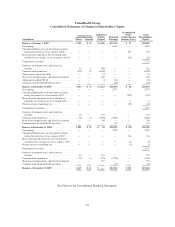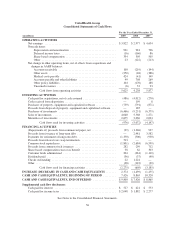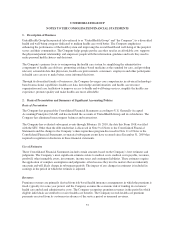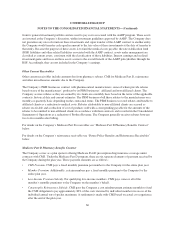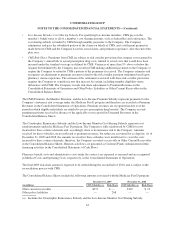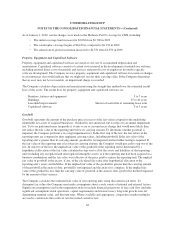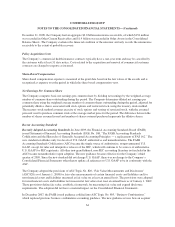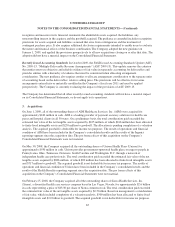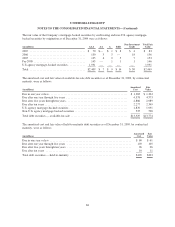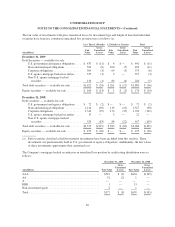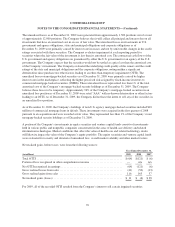United Healthcare 2009 Annual Report Download - page 66
Download and view the complete annual report
Please find page 66 of the 2009 United Healthcare annual report below. You can navigate through the pages in the report by either clicking on the pages listed below, or by using the keyword search tool below to find specific information within the annual report.UNITEDHEALTH GROUP
NOTES TO THE CONSOLIDATED FINANCIAL STATEMENTS—(Continued)
December 31, 2008, the Company had an aggregate $2.0 billion reinsurance receivable, of which $154 million
was recorded in Other Current Receivables and $1.9 billion was recorded in Other Assets in the Consolidated
Balance Sheets. The Company evaluates the financial condition of the reinsurer and only records the reinsurance
receivable to the extent of probable recovery.
Policy Acquisition Costs
The Company’s commercial health insurance contracts typically have a one-year term and may be cancelled by
the customer with at least 31 days notice. Costs related to the acquisition and renewal of commercial customer
contracts are charged to expense as incurred.
Share-Based Compensation
Share-based compensation expense is measured at the grant date based on the fair values of the awards and is
recognized as expense over the period in which the share-based compensation vests.
Net Earnings Per Common Share
The Company computes basic net earnings per common share by dividing net earnings by the weighted-average
number of common shares outstanding during the period. The Company determines diluted net earnings per
common share using the weighted-average number of common shares outstanding during the period, adjusted for
potentially dilutive shares associated with stock options and restricted stock, using the treasury stock method.
The treasury stock method assumes exercise of stock options and vesting of restricted stock, with the assumed
proceeds used to purchase common stock at the average market price for the period. The difference between the
number of shares assumed issued and number of shares assumed purchased represents the dilutive shares.
Recent Accounting Standards
Recently Adopted Accounting Standards. In June 2009, the Financial Accounting Standards Board (FASB)
issued Statement of Financial Accounting Standards (FAS) No. 168, “The FASB Accounting Standards
Codification and the Hierarchy of Generally Accepted Accounting Principles — a replacement of FAS 162.” The
new standard establishes only two levels of U.S. GAAP, authoritative and nonauthoritative. The FASB
Accounting Standards Codification (ASC) became the single source of authoritative, nongovernmental U.S.
GAAP, except for rules and interpretive releases of the SEC, which will continue to be sources of authoritative
U.S. GAAP for SEC registrants. All other non-grandfathered, non-SEC accounting literature not included in the
ASC became nonauthoritative upon adoption. The new guidance became effective for the Company’s third
quarter of 2009. Since the new standard did not change U.S. GAAP, there was no change to the Company’s
Consolidated Financial Statements other than to update all references to U.S. GAAP to be in conformity with the
ASC.
The Company adopted the provisions of ASC Topic No. 820, “Fair Value Measurements and Disclosures”
(ASC 820) as of January 1, 2008 for fair value measurements of certain financial assets and liabilities and for
non-financial assets and liabilities measured at fair value on at least an annual basis. The provisions were adopted
for non-financial assets and liabilities not measured at fair value on at least an annual basis as of January 1, 2009.
These provisions define fair value, establish a framework for measuring fair value and expand disclosure
requirements. The adoption did not have a material impact on the Consolidated Financial Statements.
In December 2007, the FASB issued guidance codified into ASC Topic No. 805, “Business Combinations,”
which replaced previous business combination accounting guidance. The new guidance revises how an acquirer
64



